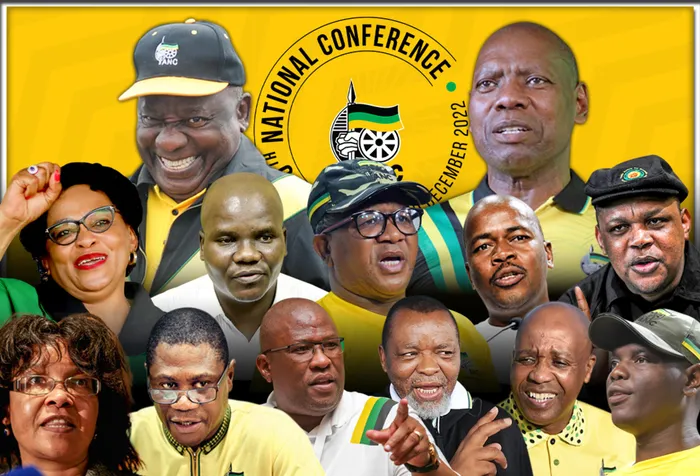The ANC Conference: Bloody Battle or Rivers of Reconciliation?

Graphic: Timothy Alexander / African News Agency (ANA)
By Kim Heller
It was on 16 December 1838 in South Africa, that the foreign Voortrekkers prepared for the Battle of Blood River against the indigenous Zulus. It was to be one of the bloodiest battles ever to be fought on South Africa’s soil.
Fast forward to 16 December 2022 and it looked like the first day of the ANC’s 55th national elective conference has kicked off what is set to be one of the bloodiest leadership battles in the history of the ANC.
The ruling party of today in South Africa is at war with itself.
Ironically, it was on December 16 in 1961 that Umkhonto we Sizwe (MK), the military wing of the African National Congress (ANC), was formed to fight against the brutal apartheid government.
Sixty-one years later, it appears as if the enemy is within, as comrades fight comrades.
Former leader of the ANC, Oliver Tambo, said rather prophetically that the only thing that can destroy the ANC is the ANC. As the ANC delves into its 55th conference, it is an the organisation that is experiencing internal rupture and haemorrhage.
It is a sad state of affairs for the oldest liberation movement in Africa.
Numerous countries on the Continent were great allies to the ANC, and pillars of immense strength and support during the war against apartheid. For these African countries, the mutation of this once-upon-a-time proud liberation movement into a flagging governing party that is battling with basic service delivery and at war with itself must be a sorry sight indeed.
The ANC enters its very own conference as a wounded party. And the wounds are self-inflicted.
It is a shell of its former self; ideologically, financially, and structurally. The policy has been held prisoner in a battle of factions. ANC staff have had to fight for salaries to be paid and the party’s league are as good as dead. The promise of renewal has long been buried and forgotten.
As for the party’s President, despite the soldiering spin of his legions in the organisation, media and markets, Cyril Ramaphosa has damaged goods after the Phala Phala fiasco and his capacity to attract financing into the country has been severely ruptured. A second term for Ramaphosa is risky from a foreign investment perspective for the President’s standing has been severely diminished. Despite this, Ramaphosa is likely to emerge victorious as President of the ANC.
If branch nominations are an accurate barometer of support, he is way ahead of any other Presidential hopefuls. What stands between him and a second term is the Phala Phala matter. Before then he was cruising effortlessly towards the finishing line. This in itself is not surprising.
Incumbents always have the added advantage of having control over various levers of influence within the state. But his victory could be short-lived for if he is charged on the Phala Phala matter, and the step-aside from rule, if it remains in place, could trip up Ramaphosa, for it would be the Deputy President who would be most likely to lead the ANC into battle in the 2024 national elections. In the game of thrones at this ANC electoral conference, the position of Deputy President is gold.
The most likely candidate for Deputy President, Paul Mashatile, who appears to have a strong constituency both in the ANC and in business, may well be the chief beneficiary of the step-aside rule. War is a game that has no rules and Mashatile could easily emerge as President in this December conference.
While many were hoping that Dr Nkosazana Dlamini-Zuma would be the first casualty of the ANC factional war, for her stance on the Section 89 vote, which went against the party line, she enters the conference with head held high and stronger than ever. Her principled stance on the Phala Phala report, which saw her set aside her own political interests in pursuit of what is right and in the interests of South Africa, may see her garner considerable support this weekend.
The lack of support for strong, accomplished, and outspoken women such as Dr Nkosazana Dlamini Zuma, and Minister Lindiwe Sisulu, for President, show up the ugly mantle of patriarchy in the ANC.
Gender and generational representation are only likely to find shape in the NEC, not in the top six.
The biggest casualty of the conference is likely to be policy itself. Scant attention is likely to be paid to matters of policy and new policy direction is unlikely.
The opening scenes of the conference suggest that it is going to more Bloody battles than Rivers of reconciliation. Like the Voortrekkers in 1838, Ramaphosa is set to win the battle. The RET faction does not seem to have grasped the art of war. Or perhaps they will surprise with a last- minute dramatic and unexpected move. Sun Tzu, in The Art of War, writes: “Attack him where he is unprepared, appear where you are not expected.” But for those who think Ramaphosa will fall or will fall easily, they may be in for disappointing days ahead. Travel writer, Brett Thomson authored an article entitled The Buffalo is the Most Dangerous of the Big Five.
Thomson says of the buffalo; “Back in the bygone era when hunting the big five was a “thing” it was said that the buffalo killed more hunters in Africa than any other animal. When wounded, they become aggressive and angry. They would seek revenge on the hunter and even remember the encounter the following day. If wounded they would circle their enemy and counter-attack, instead of fleeing. Do not anger a buffalo if you cross their path, they will charge instead of fleeing.”
Heller is a political analyst and author of ‘No White Lies: Black Politics and White Power in South Africa.’
This article is exclusive to The African. To republish, see terms and conditions.